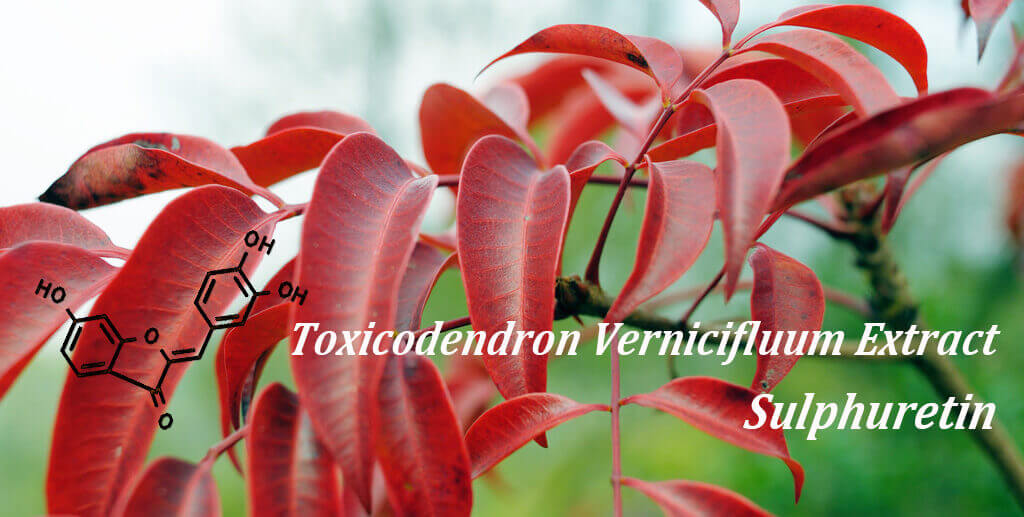Toxicodendron vernicifluum extract sulphuretin fights obesity and metabolic diseases
What is Toxicodendron vernicifluum
Toxicodendron vernicifluum, also known as Rhus vernicifluum or the Chinese Lacquer Tree, is native to China and the Indian subcontinent, and is cultivated for its sap in China, Japan and Korea. It is best known for production of sap that is prized as a decorative lacquer, and it has a history of medicinal use to stop bleeding and rid the body of parasites. And new research shows that Toxicodendron vernicifluum extract sulphuretin fights obesity and metabolic diseases, it can be an ideal dietary supplement.

Toxicodendron vernicifluum extract sulphuretin fights obesity and metabolic diseases
According to a recent study conducted by Sungkyunkwan University in South Korea, Sulphuretin, a compound that is extracted from some edible plants and flowers, can be used to prevent obesity and its related metabolic diseases. Sulphuretin is the main flavonoid compound present in the Toxicodendron vernicifluum tree and has traditionally been used as an herb, food additive and natural dye in East Asia.
The global obesity epidemic and related metabolic diseases require alternative biological targets for new treatment strategies. Based on this, the researchers tried to prove in vivo how sulphuretin prevents obesity, increases the sensitivity of obese mice to insulin in a high-fat diet and how to inhibit fat formation.
Mice and metabolic diseases
In this animal study, the researchers divided 32 male mice into an average of 4 groups: the first group fed a normal diet, the second group fed a high-fat diet, of which 60 % of the calories came from fat, the third group fed a high-fat diet, of which 30 % of the calories came from carbohydrates, and the last group fed a high-fat diet with 20 % of the calories came from protein.
For 10 weeks, researchers injected 5 mg/kg or 10 mg/kg of sulphuretin into mice in two high-fat diets groups every day , other high-fat diet group were used as control group, while mice in the normal diet group also injected 5 mg/kg to 10 mg/kg of sulphuretin daily. At the end of the treatment period, the researchers observed a significant increase in weight in mice with a high-fat diet injected with sulphuretin, liver and epididymis white adipose tissue weight also slightly increased.
Meanwhile, the lipid accumulation in these mice livers reduced, adipose cell decreased, fasting serum glucose, triglyceride and total cholesterol levels decreased as well. In addition, taking sulphuretin can inhibit the inflammatory medium of tumor necrosis factory-α(TNF-α) and reduce the content of TNF-α in the liver, which indicates that it has potential application value in improving insulin sensitivity for obese mice with high fat diet.
Cells influence and fights obesity
In vivo studies, researchers found that sulphuretin can inhibit lipid accumulation and reduce the expression of fatty cell markers. It can also inhibit the formation of fat in certain fat cells and inhibit the expression of Pparγ、Fabp4、C/ebpα, and Cd36 proteins, which are related to the pathology of diseases such as obesity and diabetes. Sulphuretin is also known as Induced Activation Transcription Factor 3(ATF-3), a protein produced in various tissues through physiological and cellular stress, which has been shown to inhibit lipid accumulation and fat production.
In a word, animal model tests have confirmed that sulphuretin has various health effects, including allergy relief, arthritis, lymphedema, cranial defect attenuation, and prevention of type 1 diabetes. In view of the (high-fat) diet induced response in obese mice, sulphuretin may provide a new method for the prevention and treatment of obesity and related metabolic diseases. However, due to the possible differences in life expectancy and metabolism between humans and mice, the effect of sulphuretin needs to be further explored with a view to preventing human metabolic diseases.


